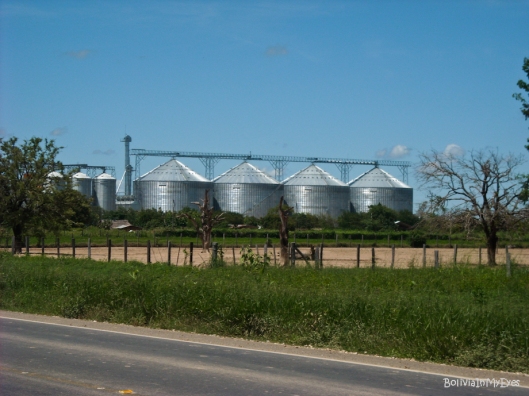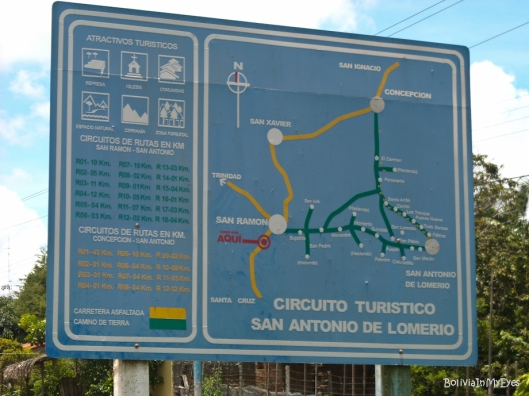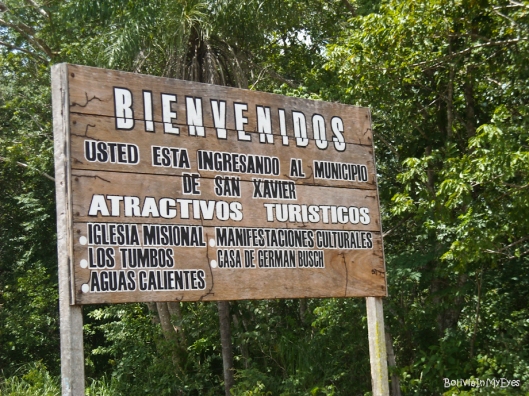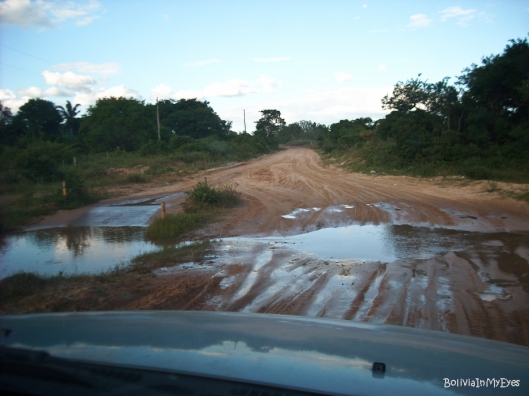Nie tak dawno temu z okazji wycieczki donikad wspominalam, iz mamy nadzieje podrozowac samochodem tylko po asfaltowych drogach. Coz, zycie zweryfikowalo nasze marzenia i oczekiwania, bowiem po wczorajszej wyprawie do San Xavier, jezuickiego kosciola misyjnego, zmienilismy zdanie. Teraz Freddy chce kierowac jednynie na ‘polnych drogach’. Posluchajcie dlaczego:)
Zaopatrzeni w mape drogowa, zaczelismy nasza kolejna podroz od nowej czteropasmowej ‘autostrady’ Santa Cruz- Cotoka. Dzien zapowiadal sie wspaniale do tego stopnia, ze wgapiona w blekitne niebo, przegapilam zjazd w kierunku ‘Puerto Suarez‘. Bez problemu jednak zawrocilismy i po chwili znalezlismy sie na znajomej drodze prowadzacej do miasteczka El Pailon, skad podazylismy droga krajowa prowadzaca do Trinidadu.
Po 5o km dziurawej jak ser szwajcarski szosy, bylismy zmuszeni zaplacic 11 Bs. za przejazd. Na odwrocie biletu, ktorego bron Boze nie mozna bylo wyrzucic, bo sprawdzano go jeszcze kilkaktotnie, bylo napisane, ze pieniadze ida na utrzymanie drog. W wypadku tej, poszly one chyba jednak na cos innego. Nastepnych 70 kilometrow bylo prawdziwa udreka – zamiast wpatrywac sie w piekny zielony krajobraz za oknem, zmuszeni bylismy wypatrywac dziur w asfaltowej nawierzchni, jadac slalomem po prostej drodze. Niewielu kierowcow bylo jednak tak ostroznych, bo wiekszosc nas wyprzedzala. Prym wiodly ogromne autobusy, ktorym nie straszne byly ani dziury, ani inne pojazdy jadace z naprzeciwka. Pedzily one z szybkoscia co najmniej 100 km na godzine i szybko znikaly za horyzontem.




Przypomnialy mi sie slowa naszej znajomej, ktora opowiadala, jak latwo, szybko i przyjemnie podrozuje sie w obranym przez nas kierunku, wlasnie autobusem. Coz, turysta zamkniety w blaszanej puszce nie zdaje sobie sprawy jak taka podroz wyglada z punktu widzenia kierowcy i innych uzytkownikow drogi… Ja autobusem raczej tam nie pojade.
Po kilkudziesieciu kilometrach droga ulegla jednak transfrmacji i Freddy mogl w koncu rozprostowac nogi (szczegolie prawa) a samochod ‘rozwinac skrzydla’. W pobliskim miasteczku ‘Los Troncos’ czekala nas jednak niespodzianka. Przed kolejnym punktem oplat za przejazd, stala sobie drewniana budka, w budce siedzial policjant rozmawiajacy przez komorke, oraz mezczyzna operujacy lina. Kolo budki zas krecily sie dzieciaki sprzedajace slodycze i orzechy, czekajace na potencjalnych klientow. Jak sie zas pozniej okazalo – na ofiary.
Pan z lina zagrodzil nam droge, a policjant kazal wysiasc z auta, po czym wlepil Freddiemu mandat za przekroczenie szybkosci, w wysokosci 35 dolarow. Taki sam mandat dostal jadacy za nami kierowca autobusu. Z doswiadczenia innych osob wiemy, ze z wladza sie nie dyskutuje, mozna jednak negocjowac i tak zamiast 35, Freddy zaplacil 20 dolarow, w tym celu udajac sie do srodka drewnianej budki.
Po chwili bylismy znow w drodze, ale nasze poczatkowe podekscytowanie podroza minelo. Po przedyskutowaniu calego zajscia doszlismy jednak do wniosku, ze trzeba sie uczyc na bledach. Mimo braku znakow ograniczenia predkosci na wiekszosci odcinkow drogi, postanowilismy ze na otwartym terenie nie przekraczamy 75 km/g, zblizajac sie do terenu zabudowanego zwalniamy do 50, a w samym miasteczku czy wiosce, poruszamy sie z predkoscia 35 km/g. Zreszta, dziury w nawierzchni i tak nie pozwalaja na wiecej. Nie wiem, czy taka jazda uchronilaby nas przed mandatem, ale przynajmniej moglibysmy z czystym sumieniem zwalic cala wine na skorumpowanego policjanta:)
Po drodze, zatrzymalismy sie na chwile w miasteczku San Ramon, gdzie kupilismy wode i zrobilismy zdjecia budce telefonicznej w ksztalcie jaguara.


Wszystkie mijane przez nas miasteczka i wioski wygladaly zreszta podobnie – budynki usytuowane wzdluz drogi funkcjonuja tu jako sklepy i punkty uslugowe, a sama ulica jest miejscem drobnego handlu. Samochody poruszaja sie wiec pomiedzy glosnym tlumem sprzedawcow i kupujacych, w slimaczym tempie.


W San Ramon glowna droga do Trynidadu ulegla rozwidleniu – my podazylismy w prawo, zegnani, jak niedawno witani, znakiem Coca-Coli.

Nastepne 50 km uplynelo w spokojnej atmosferze, a nerwowa napiecie w koncu ustapilo zachwytowi nad zmieniajacym sie krajobrazem. Tuz za San Ramon, plaski i monotonny pejzarz nakrapiany rozleglymi haciendami i ogromnymi srebrnymi silosami, momentami przypominajacy mi rolnicze rejony polnocnej Polski, przemienil sie w pagorkowata kraine, bardziej zielona niz szmaragdowa Irlandia!






Przekraczajac granice San Javier (Xavier), bylismy niemal w raju. Jednak nasze szczescie zaklocil fakt, iz po polgodzinnym wypatrywaniu slynnego kosciola, nadal bylismy w szczerym polu! Co roz mijalismy zas ogromne tablice, informujace nas o bogatej historii tego regionu.

Kiedy zobaczylismy na horyzoncie czerwone dachy domow, wiedzielismy, ze dotarlismy do celu.
cdn.
* Podrozujac samochodem po Boliwii mozna natknac sie na kilka przeszkod: punkty oplat za przejazd, punkty kontrolne, dziury w asfalcie, brak asfaltu. Wypszedzajace na trzeciego samochody osobowe, ciezarowki, autobusy i motocyklisci. Uwazac trzeba rowniez na samopasace sie przy drodze stada krow i koz oraz aligatory przechodzace przez jezdnie! Jednego widzielismy na wlasne oczy. Niestety wygladal na takiego, ktoremu sie nie udalo…

** Lepiej nie dyskutowac z wladza. Slyszalam i czytalam historie osob, przede wszystkim ‘grongos’, ktore zostaly zatrzymane na punkcie kontrolnym i ‘poproszone’ o zaplacenie mandatu. Za co? Za wszystko i za nic. Albo jechal za szybko, albo jechal za wolno, pil piwo na tylnym siedzeniu taksowki itd. Zwykle policjanci prosza zatrzymana osobe na tyly przydrozengo posterunku i tam pobieraja oplate, wedlug wlasnego cennika. Ceny wahaja sie od 100 dolarow do kilkudziesieciu boliwianos (w zaleznosci od szczescia i zdolnosci negocjacyjnych). Jezeli zatrzymany odmawia zaplaty, moze on zostac aresztowany lub przytrzymany caly dzien na posterunku. Decyzja nalezy wiec do ciebie – plac lub placz. Slyszalam rowniez, ze takie praktyki wymuszania haraczu sa zwalczane, ale obawiam sie, ze policja boliwijska jest na tyle skorumpowana, ze sa to przypadki sporadyczne.
*** W Boliwii jak w kazdym innym kraju funkcjonuja ograniczenia predkosci, tylko nie zawsze sa one znane i egzekwowane przez kierowcow. Ja zaobserwowalam takie zasady:
– autostrady (lub drogi szybkiego ruchu je przypominajace) – 80 km/g
– glowne drogi krajowe – 75 km/g
– tereny zabudowane – 50 km/g
– centra miasteczek i miast – 35 km/g.
Inna sprawa jest to, ze czasem na prostym kawalku ‘zalatanej’ szosy posrod lasow, pojawia sie znak ograniczenia predkosci do 35 km/h. I badz tu madry, czlowieku!
**** W sezonie letnim (deszczowym), wiele odcinkow drog zostaje podtopionych, a drogi lokalne (piaszczyste) zamieniaja sie w blotne rzeki. My jednak uznalismy glowne asfaltowe trasy za bardziej niebezpieczne, bowiem mimo iz znajduja sie one raczej w zlym stanie, dzialaja na lokalnych kierowcow jak plachta na byka.
Mimo to, nawet na ‘polnych drogach’ trzeba uwazac. Wezmy za przyklad droge do Porongo (te dluzsza przez most, bo jest jeszcze krotsza przez rzeke:), ktora jest w budowie. Buduja ja juz od roku i konca nie widac! Ba! trudo jest nawet okreslic jej poczatek, bo asfaltowe kawalki wyrastaja z ziemi znienacka i trzeba uwazac na wystajace z nich druty! Niektorzy je omijaja, wybierajac piaszczyste pobocze.




***** O mapach pisalam wczesniej —> Mapy drogowe Boliwii, a jeszcze wczesniej o innych sposobach ‘Podrozowania po Boliwii‘.
Wiecej o boliwijskich drogach i bezpiecznej podrozy samochodem na —> Bolivia Bella (po angielsku).

***
I mentioned not so long ago, on the occasion of a trip to nowhere, that we hope to travel by car only on asphalt roads. Well, life has verified our dreams and expectations, because after yesterday’s trip to San Xavier, the Jesuit missionary church, I changed my mind. Now Freddy wants to drive only on the ‘dirt roads’. Why? Listen to this story:)
Equipped with the road map, we started our trip on the new four-lane ‘highway’ Santa Cruz – Cotoka. The day had started beautifully to the extent, that staring at blue sky, I missed the exit to ‘Puerto Suarez’. However, that was no problem – we turned around and soon found ourselves on a familiar road leading to the town of El Pailon, following the main national road to Trinidad.
After 50 km of a holey as Swiss cheese road, we were forced to pay 11 bs. toll. On the back of the ticket, that thanks God we didn’t throw away, as it was checked lots of times on the way, it was written that the money go for the roads maintenance. In this case the money must have gone somewhere else. The next 70 kilometers were a real chore – instead of admiring the beautiful green landscape outside the window, we were forced to look out for holes in the asphalt, driving slalom on a straight road. Few drivers were as cautious as us, because most of them overtook our car. Among theme were huge buses, which weren’t scared of holes or other vehicles coming from the opposite direction. They raced with the speed of at least 100 km per hour, quickly disappearing behind the horizon.
I remembered our friend’s stories, how easy, fast and fun is travelling in that direction by bus. Well, the tourist closed in a tin box do not realize how this trip looks like from the driver’s or the other road users’ point of view… Knowing what I know, I would never go there by bus.
After couple of kilometers, the road undergone real transformation and Freddy could finally stretch his legs (especially the right one) allowing the car to spread its wings. In the nearby village of Los Troncos however, the surprise was waiting for us. Before the next toll point, there was a wooden booth, with a police officer talking on a cell phone, the man operating the rope and some kids vending sweets and nuts, waiting for potential customers. Or rather, as it turned out later – victims.
The man with the rope stopped our vehicle, and the policeman ordered to get off the car, giving Freddy a fine for speeding. The bus driver behind us was also fined. From the experience of other people we know that it’s better not to discuss with authorities, however, one can negotiate and so instead of 35 dollars, Freddy paid 20 dollars, going inside a wooden booth. No receipt was written.
After a while, we were again on the road, but we have lost our initial excitement. When discussing the incident, we came to the conclusion that we need to learn from our little adventure. Despite the lack of speed limit signs, we decided not to exceed 75 km / h on the open road, by approaching the built-up area slow down to 50, and in the town centre drive 35 km / h. Hols in the road would not allow for more anyway. I don’t know whether such precaution would protect us against the fine, but at least we could fully blame it on a corrupt police officer :)
Along the way, we stopped for a moment in the town of San Ramon, where we bought water and we took some pictures of phone booth in the shape of a jaguar. All towns and villages on the way looked alike – buildings located along the road are converted to shops and service points, and the street itself is a place of petty trade. Cars move along between a loud crowd of vendors and buyers at a snail’s pace. At San Ramon, we left the main road to Trinidad, keeping to the right, and being blessed again by Coca -Cola sign, wishing us a nice trip.
The next 50 km elapsed in a peaceful atmosphere, and all nervous tension eventually gave way to delight over a changing landscape. Just outside San Ramon, the flat and monotonous scenery dotted with extensive haciendas and huge silver silos, so reminiscent of agricultural regions of northern Poland, transformed into a hilly land, much greener than Ireland!
Crossing the boundaries of San Javier (Xavier), we were almost in paradise. But our happiness and sense of relief was disturbed by the fact that after half an hour of driving, the famous church was nowhere to be seen! We passed however by many big boards informing us of the rich history of this region.
Eventually, we saw on the horizon some red roofs and we knew that we reached our target.
To be continued…
* Traveling by car in Bolivia, one can come across few obstacles: tolls, checkpoints, holes in the asphalt, no asphalt. Overtaking cars, lorries, buses and motorcyclists. There are also loosely herds of cows and goats and even alligators crossing the road! One such we have seen with our own eyes. Unfortunately, it looked like it didn’t make it, long before us.
** Better not to discuss with the authorities. I heard and I read stories of people, especially ‘gringos’, who were stopped at a checkpoints and ‘asked’ to pay a fine. What for? For everything and for nothing: because of driving too fast or too slowly or drinking beer on the backseat of a cab etc. Usually, the police asks detained person to the back of the building to pay a fee, according to his own price list. Prices range from 100 dollars to tens bolivianos (depending on luck and negotiation abilities). If detained refuses payment, he may be arrested or held all day at the station. I heard that such practices are being punished, but I’m afraid that Bolivian police is so corrupt that these are sporadic cases.
*** In Bolivia, as in every other country, there are official speed limits, but they are not always known and applied by the drivers. I observed these rules:
– Highways – 80 km / h
– Main roads – 75 km / h
– Built-up areas – 50 km / h
– Centers of towns and cities – 35 km / h
Another thing is that sometimes a speed limit sign of 35 km / h appears on the straight good road in the middle of forest. So, go figure!
**** In rainy season some parts of the roads, especially dirt roads, are flooded, making it very dangerous to drive through. But we found asphalt roads more hazardous. They are badly maintained but local drivers go crazy on them! However, dirty roads are not always so safe. For example road to Porongo (the one through the bridge, because as I heard there is another, shorter one via river:) that is being build. It’s been a year now and there is no end even close. Bah! It’s even hard to say when the road works start, as the strips of asphalt appear suddenly in the middle of nowhere. And there are metal roads sticking out of them! No wonder some people decide to drive along on the dirt sideways.
***** I wrote lately about maps—–> Bolivia Road Maps and much earlier about ‘Travelling in Bolivia‘ in other ways.
Read more about Bolivian roads and driver’s safety at —> Bolivia Bella.
























